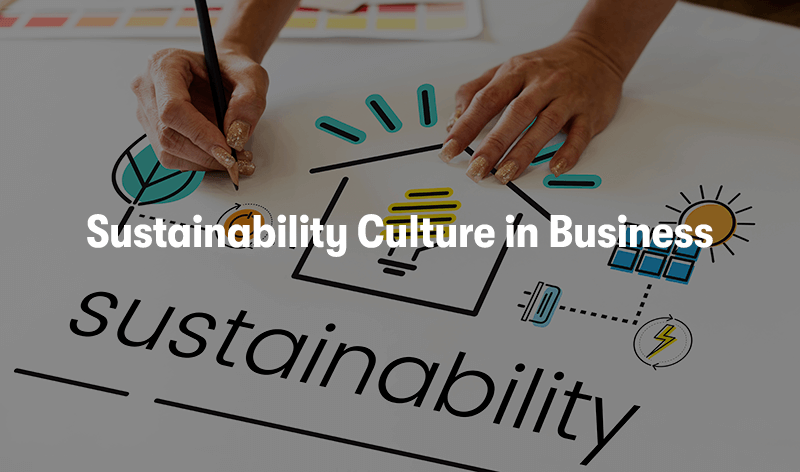Sustainability Culture in Business - A Complete Guide
Welcome to our exploration of a topic that has taken centre stage in today's business landscape: Sustainability Culture in Business. In this blog series, we embark on a journey to understand the profound impact of fostering a sustainability culture within organisations.
Sustainability culture goes beyond mere environmental practices; it embodies a commitment to responsible business conduct, encompassing environmental stewardship, social responsibility, and economic viability. Through this series, we will unravel the key components of sustainability culture, from leadership commitment and employee engagement to transparency, innovation, and long-term thinking.
We will also delve into the historical evolution of sustainable business culture, tracing its roots and milestones, and examine its pivotal role in addressing the pressing challenges of our time, from climate change to social equity.
Join us on this enlightening journey as we explore how businesses can embrace sustainability culture to thrive in an ever-changing world while positively impacting the planet and society.
What is a Sustainability Culture in Business?
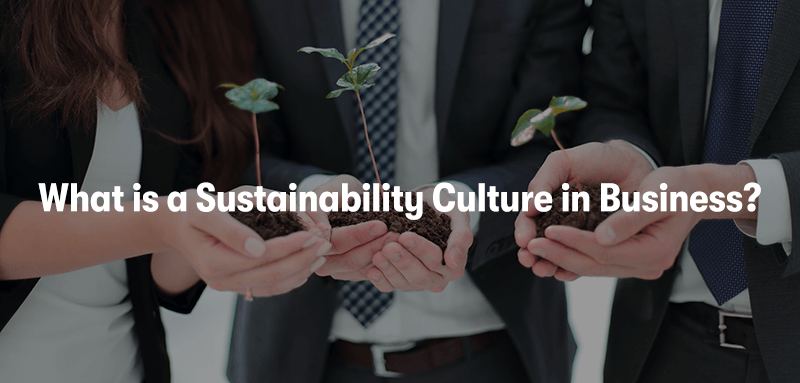
A sustainability culture in business refers to the set of values, beliefs, attitudes, and practices within an organisation that prioritise and promote sustainability as a core aspect of its operations and decision-making processes. It involves integrating environmental, social, and economic considerations into all aspects of business strategy and daily activities. A sustainability culture goes beyond simply adopting green practices; it represents a fundamental shift in how a company thinks about its impact on the planet, people, and profits. Key components of a sustainability culture in business include:
Environmental Responsibility
Companies with a sustainability culture actively work to reduce their environmental footprint. They might implement energy-efficient practices, reduce waste, use sustainable materials, and minimise greenhouse gas emissions. Environmental stewardship is a fundamental part of their identity.
Social Awareness
Businesses in a sustainability culture are concerned with the well-being of their employees, customers, and the communities they operate in. They may engage in fair labour practices, support diversity and inclusion, and contribute positively to the communities in which they do business.
Long-Term Thinking
A sustainability culture emphasises long-term thinking over short-term gains. This means considering the consequences of decisions on future generations and focusing on sustainable growth and profitability.
Stakeholder Engagement
Companies in a sustainability culture actively engage with stakeholders, including employees, customers, investors, and regulators, to gather input and ensure that their sustainability efforts align with the expectations and needs of these groups.
Transparency and Reporting
Transparency is a hallmark of a sustainability culture. Businesses disclose their sustainability goals, progress, and challenges through regular reporting. This transparency builds trust with stakeholders and allows for accountability.
Innovation and Continuous Improvement
Organisations with a sustainability culture encourage innovation in sustainability practices. They are always looking for new and better ways to reduce their impact on the environment, enhance social responsibility, and improve their economic performance.
Leadership Commitment
Leadership at all levels of the organisation plays a crucial role in fostering a sustainability culture. When top executives and managers demonstrate a genuine commitment to sustainability, it sets the tone for the entire company.
Integration into Strategy
Sustainability is not seen as a separate initiative but is integrated into the core business strategy. It is considered a competitive advantage and a driver of long-term success.
Education and Training
Businesses invest in educating their employees about sustainability principles and provide training to ensure that everyone understands and contributes to the company's sustainability goals.
External Partnerships
Companies in a sustainability culture often collaborate with external partners, such as NGOs, suppliers, and industry associations, to leverage collective efforts to address sustainability challenges.
In summary, a sustainability culture in business is a holistic approach to incorporating environmental, social, and economic sustainability into an organisation's DNA. It involves a genuine commitment to responsible business practices, considering the broader impact of actions and decisions on the planet, society, and the bottom line.
Why is a Culture of Sustainability in Business Important?
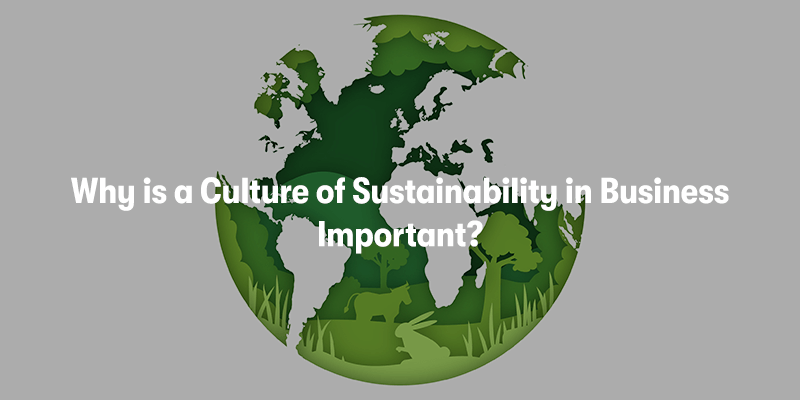
A culture of sustainability in business is important for several compelling reasons:
Environmental Stewardship
A culture of sustainability demonstrates a commitment to environmental responsibility. By reducing the environmental impact of operations, businesses can help mitigate the effects of climate change, protect natural resources, and contribute to a healthier planet.
Competitive Advantage
Sustainability practices can provide a competitive edge in the market. Consumers are increasingly conscious of environmental and social issues and often prefer supporting businesses that share their values. A sustainability culture can attract and retain environmentally conscious customers, leading to increased market share and customer loyalty.
Cost Savings
Sustainability initiatives often lead to cost savings. Energy-efficient operations, waste reduction, and resource optimisation can lower operational expenses over time. Sustainable practices can also reduce risks associated with price fluctuations in non-renewable resources.
Innovation and Adaptability
Embracing sustainability encourages innovation. Companies prioritising sustainability are more likely to develop and adopt new technologies and business models better aligned with changing societal and environmental needs. This innovation can position them as leaders in their industries.
Regulatory Compliance
Many governments and regulatory bodies are imposing stricter environmental and social regulations. A culture of sustainability helps businesses stay ahead of compliance requirements and avoid potential legal and financial risks associated with non-compliance.
Risk Mitigation
Sustainability efforts can reduce risks related to supply chain disruptions, reputation damage, and changing customer preferences. By diversifying suppliers, managing environmental impacts, and demonstrating social responsibility, businesses become more resilient in the face of uncertainties.
Employee Engagement and Talent Attraction
A strong sustainability culture can attract and retain top talent. Employees often want to work for organisations that align with their personal values, and a commitment to sustainability can improve employee morale and job satisfaction.
Long-Term Profitability
Sustainable business practices are often associated with long-term profitability. By considering the social and environmental impacts of decisions, businesses can create more resilient and enduring business models that are less vulnerable to shocks and crises.
Reputation and Brand Enhancement
A sustainability culture can enhance a company's reputation and brand value. Positive public perception and brand loyalty can lead to increased sales and market share.
Ethical and Ethical Considerations
For many organisations, sustainability is not just a business strategy; it's an ethical imperative. It reflects a commitment to doing what is right for the planet, society, and future generations, which can resonate with employees, customers, and investors.
Global Supply Chain Resilience
Sustainability practices can strengthen supply chain resilience by reducing dependencies on limited resources, minimising waste, and diversifying sourcing options.
Future-Proofing
As the world faces increasing environmental and social challenges, businesses prioritising sustainability are better positioned to adapt to changing conditions and emerging market demands, ensuring long-term viability.
In conclusion, a culture of sustainability in business is essential because it aligns with ethical values, enhances competitiveness, reduces costs, mitigates risks, attracts talent, and positions the organisation for long-term success in an ever-changing world. It's a responsible choice and a strategic one that can lead to financial and societal benefits.
Creating a Culture of Sustainability for Your Business

Creating a culture of sustainability for your business involves a deliberate and comprehensive approach to embedding sustainability principles into your organisation's values, operations, and decision-making processes. Here are steps to help you establish a sustainability culture within your business:
Leadership Commitment
Start at the top. Leadership commitment is essential for driving sustainability initiatives. Top executives should champion sustainability and set a clear example for the rest of the organisation.
Define Sustainability Goals
Establish clear and measurable sustainability goals that align with your business strategy. These goals should cover environmental, social, and economic aspects of sustainability.
Engage Employees
Involve your employees in the sustainability journey. Educate them about the importance of sustainability and provide training to build their skills and awareness.
Create Cross-Functional Teams
Form cross-functional teams or committees dedicated to sustainability. These teams can help identify opportunities, set targets, and monitor progress.
Develop Sustainability Policies and Procedures
Develop and implement sustainability policies and procedures that guide your organisation's actions and decisions. Ensure these policies are well-communicated and enforced.
Measure and Report Progress
Implement key performance indicators (KPIs) and data collection systems to regularly monitor and report on sustainability progress. Transparency is essential in demonstrating your commitment.
Integrate Sustainability into Strategy
Integrate sustainability into your overall business strategy. Ensure that sustainability considerations are part of your strategic planning process.
Green Procurement
Consider sustainable sourcing and procurement practices. Work with suppliers who share your sustainability values and prioritise environmentally friendly and ethical sourcing.
Energy Efficiency and Resource Management
Implement energy-efficient technologies and resource management practices to reduce waste, energy consumption, and water usage.
Waste Reduction and Recycling
Establish recycling programs and initiatives to reduce waste generation. Encourage employees to recycle and reduce waste at work.
Community Engagement
Engage with your local community and participate in community sustainability initiatives. Demonstrating your commitment to local sustainability can enhance your reputation.
Employee Involvement
Encourage employees to contribute their ideas and suggestions for sustainability improvements. Recognise and reward sustainability efforts.
Educational Initiatives
Educate your customers, suppliers, and partners about your sustainability initiatives. This can build support and create a positive ripple effect.
Innovation and Research
Invest in research and development to identify innovative sustainability solutions that can improve your products, services, and processes.
Regularly Review and Adapt
Sustainability is an ongoing process. Regularly review your sustainability initiatives, assess your progress, and adapt your strategies as needed.
Certifications and Standards
Consider obtaining relevant sustainability certifications or adhering to recognised sustainability standards. This can provide external validation of your efforts.
Communication and Marketing
Share your sustainability achievements and progress with stakeholders through clear and transparent communication. This can enhance your brand and reputation.
Set Long-Term Goals
Beyond immediate objectives, set long-term sustainability goals that reflect your commitment to making a lasting positive impact.
Remember that creating a culture of sustainability is a journey that takes time. It requires ongoing commitment, engagement, and adaptation as your business evolves and the sustainability landscape changes. By integrating sustainability into your core business practices and involving all stakeholders, you can foster a culture that prioritises sustainability and contributes to a more sustainable future.
What is the History of Sustainable Business Culture?
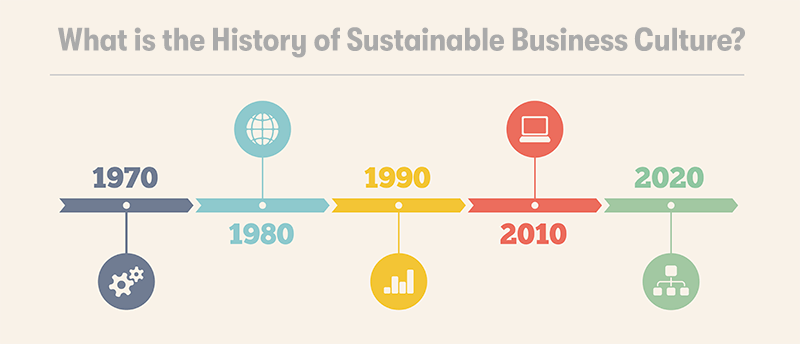
The history of sustainable business culture can be traced back several centuries, but the modern concept of sustainability in business has evolved significantly over the past few decades. Here's a brief overview of its historical development:
Early Roots (18th to 19th Century)
The earliest evidence of sustainability in business can be seen in practices that promote responsible resource management. For example, concepts like "sustained yield" and "selective cutting" emerged in the 18th and 19th centuries, aiming to ensure that forests could continue to provide wood indefinitely.
Industrial Revolution (18th to 19th Century)
The Industrial Revolution brought significant advancements in technology and productivity but also led to environmental degradation and exploitation of natural resources. It marked a turning point, highlighting the need for more responsible industrial practices.
Conservation Movement (Late 19th Century)
In the late 19th century, the conservation movement gained momentum. Figures like John Muir and Theodore Roosevelt advocated for protecting natural lands, leading to the establishment of national parks and a growing awareness of the need to preserve the environment.
Early Environmentalism (20th Century)
The mid-20th century saw the rise of modern environmentalism, with events like the publication of Rachel Carson's "Silent Spring" in 1962 drawing attention to the harmful effects of pesticide use. This period laid the foundation for increased environmental awareness.
1970s Environmental Movement
The 1970s marked a significant milestone with the first Earth Day in 1970 and the establishment of the U.S. Environmental Protection Agency (EPA). Environmental regulations began to emerge, influencing corporate practices.
1980s to 1990s: Corporate Responsibility and Sustainability Reporting
During this period, businesses started to recognise the importance of corporate social responsibility (CSR) and began reporting on their environmental and social impacts. Sustainability reporting and triple-bottom-line accounting emerged as tools to measure and communicate sustainability efforts.
Late 1990s to Early 2000s: Global Sustainability Initiatives
International sustainability initiatives gained traction in the late 1990s and early 2000s. The United Nations Global Compact (2000) and the Global Reporting Initiative (GRI), launched in 1997, were key developments promoting corporate sustainability.
2000s to Present: Mainstreaming Sustainability
Sustainability has become more mainstream in the business world. Many companies have adopted sustainability strategies as a core part of their operations, driven by factors like consumer demand, investor interest, and regulatory pressures.
Sustainable Development Goals (SDGs)
In 2015, the United Nations adopted the 17 Sustainable Development Goals (SDGs), providing a global framework for addressing environmental, social, and economic challenges. Many businesses align their sustainability efforts with these goals.
Recent Developments: Climate Action and Circular Economy
Climate action and the transition to a circular economy have gained prominence in recent years. Businesses are increasingly focused on reducing carbon emissions, promoting renewable energy, and minimising waste.
COVID-19 Pandemic (2020s)
The COVID-19 pandemic underscored the interconnectedness of global challenges. Many businesses have responded by emphasising the importance of resilience, social responsibility, and sustainability in their recovery strategies.
Throughout this history, sustainability in business has evolved from a niche concept to a fundamental aspect of corporate strategy. Today, it encompasses environmental stewardship, social responsibility, ethical governance, and long-term economic viability. As environmental and social challenges continue to mount, sustainable business practices will likely become even more central in the global economy.
Employee, Economic and Environmental Sustainability
Employee, economic, and environmental sustainability are three critical dimensions of sustainability that businesses must consider to achieve a holistic and responsible approach to their operations. These dimensions are often referred to as the "triple bottom line," emphasising that success should be measured not only by financial profits but also by social and environmental impacts. Here's an overview of each dimension:
Employee Sustainability
Employee sustainability focuses on the well-being, engagement, and development of an organisation's workforce. It encompasses several key aspects:
Workplace Safety and Health: Ensuring a safe and healthy working environment is essential for employee sustainability. Businesses should adhere to safety regulations, provide proper training, and maintain facilities prioritising employee well-being.
Fair Employment Practices: Treating employees fairly and ethically is crucial. This includes fair wages, non-discrimination, equal opportunities, and the absence of exploitative labour practices.
Employee Development: Supporting employees' professional growth through training, skill development, and career advancement opportunities contributes to employee sustainability. It can enhance employee satisfaction and retention.
Work-Life Balance: Promoting work-life balance through flexible work arrangements, reasonable working hours, and policies supporting personal and family needs can improve employee well-being.
Diversity and Inclusion: Embracing diversity and fostering an inclusive workplace culture is essential. A diverse workforce can lead to greater creativity, innovation, and better decision-making.
Employee Engagement: Engaged employees are more productive and committed to their organisation's success. Strategies to boost employee engagement include recognition programs, open communication, and employee involvement in decision-making.
Economic Sustainability
Economic sustainability refers to the ability of a business to generate long-term, profitable growth while considering the broader economic impacts of its activities. Key components of economic sustainability include:
Profitability: While economic sustainability considers more than just profit, profitability is still vital. Businesses must generate profits to reinvest in sustainability initiatives and support long-term growth.
Financial Resilience: Being financially resilient means being able to withstand economic downturns and unforeseen challenges. A sustainable business maintains healthy financial reserves and diversifies revenue streams.
Responsible Finance: Ethical financial practices, including responsible lending, investing, and financial decision-making, are essential for economic sustainability. Businesses should avoid harmful financial practices that contribute to economic inequality or instability.
Supply Chain Responsibility: Economic sustainability extends to the entire supply chain. Businesses should promote fair and ethical practices throughout their supply chains, ensuring suppliers and partners benefit from economic sustainability.
Innovation and Adaptability: Embracing innovation and adapting to changing market conditions is critical for long-term economic sustainability. This includes staying ahead of industry trends and addressing emerging challenges.
Environmental Sustainability
Environmental sustainability focuses on minimising the negative environmental impacts of business operations while promoting responsible resource use and conservation. Key aspects of environmental sustainability include:
Resource Efficiency: Businesses should strive to reduce resource consumption, optimise energy use, and minimise waste generation. Energy-efficient technologies, renewable energy adoption, and waste reduction programs contribute to this aspect.
Sustainable Sourcing: Using sustainable and responsibly sourced materials and inputs is crucial. This includes considering the environmental impact of raw materials and supply chain processes.
Carbon Footprint Reduction: Mitigating greenhouse gas emissions and working towards carbon neutrality are central to environmental sustainability. Businesses can achieve this through initiatives like carbon offsetting and adopting clean energy sources.
Biodiversity Conservation: Protecting biodiversity and natural ecosystems is a key element of environmental sustainability. This may involve habitat restoration, responsible land use practices, and conservation efforts.
Circular Economy: Transitioning to a circular economy model, which promotes reuse, recycling, and waste reduction, is a fundamental approach to environmental sustainability.
Environmental Compliance: Businesses must adhere to environmental laws and regulations. Proactive efforts to exceed compliance requirements can demonstrate a commitment to environmental sustainability.
Balancing employee, economic, and environmental sustainability is a complex challenge. Still, it is essential for businesses looking to thrive long-term while contributing positively to society and the planet. By integrating these dimensions into their core strategies, companies can create value not only for shareholders but also for employees, communities, and the environment.
Where do Businesses Struggle When Creating a Culture of Sustainability?
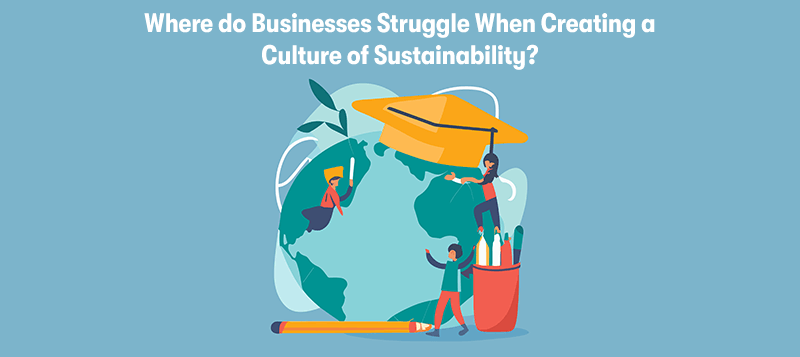
Businesses often encounter several challenges and struggles when attempting to create a culture of sustainability. These challenges can vary depending on the industry, the size of the organisation, and the existing corporate culture. Here are some common areas where businesses may face difficulties:
Lack of Leadership Commitment
Sustainability initiatives often require a significant commitment from top leadership. When senior executives are not fully on board or do not prioritise sustainability, it can be challenging to gain traction.
Short-Term Focus and Financial Pressures
Businesses may prioritise short-term financial goals over long-term sustainability objectives. The pressure to meet quarterly or annual financial targets can hinder investments in sustainability initiatives.
Resistance to Change
Employees, especially in well-established organisations, may resist changes in their work routines or processes required for sustainability. This resistance can impede the adoption of sustainable practices.
Limited Resources
Many businesses face resource constraints, such as budget limitations or a lack of specialised personnel for sustainability initiatives. Limited resources can hinder the implementation of sustainability programs.
Complex Supply Chains
Businesses with complex supply chains may struggle to ensure sustainability standards are met at every stage. Managing suppliers' sustainability practices and verifying compliance can be challenging.
Measurement and Reporting
Accurately measuring and reporting sustainability performance can be complex. Establishing reliable data collection and reporting systems is crucial but can be time-consuming and costly.
Balancing Conflicting Interests
Balancing the interests of various stakeholders, including shareholders, employees, customers, and the environment, can be challenging. Decisions that benefit one group may conflict with the interests of another.
Regulatory Uncertainty
Evolving and uncertain regulatory landscapes, including changes in environmental regulations, can make it difficult for businesses to plan and implement long-term sustainability strategies.
Consumer Expectations
Meeting evolving consumer expectations for sustainable products and practices can be challenging, especially when consumer demands shift rapidly.
Risk Management
Assessing and mitigating sustainability-related risks, such as supply chain disruptions due to climate change or reputation damage from environmental incidents, can be complex and costly.
Integration into Core Strategy
Integrating sustainability into the core business strategy can be challenging, as it often requires a fundamental shift in mindset and decision-making processes.
Communication and Transparency
Effectively communicating sustainability efforts and progress to stakeholders can be difficult. A lack of transparency or inadequate communication can erode trust.
Long-Term Perspective
Sustainability often involves a long-term perspective, which may clash with short-term profit-seeking objectives. Convincing stakeholders to invest in long-term sustainability can be challenging.
Cultural Resistance
Existing organisational cultures may not align with sustainability values and practices. Changing the culture to embrace sustainability can take time and effort.
Complexity of Sustainability Issues
Sustainability is a multifaceted concept that covers environmental, social, and economic aspects. Understanding and addressing all these dimensions can be overwhelming.
Overcoming these challenges requires a proactive and committed approach. Successful businesses that have created a strong culture of sustainability often engage in continuous learning involve employees at all levels, set clear goals and priorities, invest in sustainability education and training, and foster a culture of innovation and adaptability. Collaboration with external stakeholders, such as industry peers, NGOs, and government agencies, can also provide valuable support in addressing these challenges.
What is Digital Sustainability?
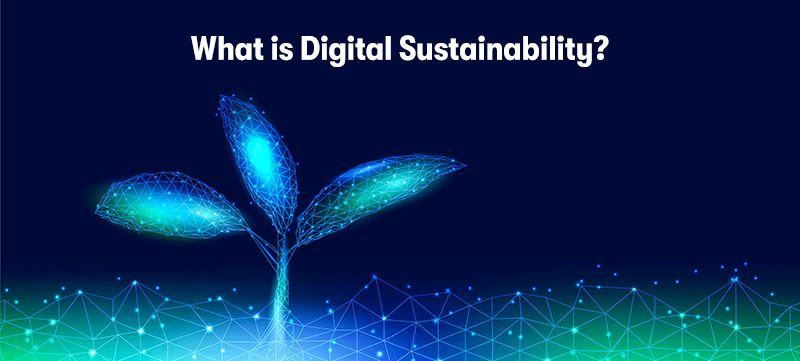
Digital sustainability refers to the responsible and sustainable use of digital technologies and resources to minimise environmental and social impacts while maximising their benefits. It involves applying sustainable practices to the development, deployment, and management of digital technologies and services. Digital sustainability is becoming increasingly important as the digitalisation of society and businesses continues to grow. Key aspects of digital sustainability include:
Energy Efficiency
Minimising the energy consumption of digital devices, data centres, and network infrastructure is fundamental to digital sustainability. This involves optimising hardware and software, using energy-efficient equipment, and leveraging renewable energy sources for data centres.
Reducing E-Waste
Managing electronic waste (e-waste) responsibly is crucial. This includes designing products for longevity and repairability, promoting recycling and responsible disposal practices, and reducing the environmental impact of electronics manufacturing.
Digital Inclusion
Ensuring equitable access to digital technologies and bridging the digital divide is a social aspect of digital sustainability. Efforts are made to make technology accessible to underserved and marginalised communities.
Data Privacy and Security
Protecting individuals' privacy and data security is an ethical dimension of digital sustainability. It involves implementing robust cybersecurity measures and complying with data protection regulations.
Sustainable Software Development
Developing software with sustainability in mind includes efficient coding practices, minimising resource-intensive processes, and considering the environmental impact of software throughout its lifecycle.
Remote Work and Telecommuting
Encouraging remote work and telecommuting can reduce the environmental impact associated with commuting to physical offices and office energy consumption.
Eco-Friendly Hardware
Manufacturing and using eco-friendly hardware components, such as low-power processors and recyclable materials, contribute to digital sustainability.
Green Data Centers
Designing and operating data centres with energy-efficient infrastructure, cooling systems, and renewable energy sources is essential to reduce the carbon footprint of data storage and processing.
Reducing Digital Clutter
Minimising digital clutter, such as unnecessary emails, files, and data storage, reduces energy consumption and resource use associated with data storage and transmission.
Sustainable Supply Chains
Evaluating and optimising the sustainability of supply chains related to digital technologies, including sourcing materials and components from ethical and environmentally responsible suppliers.
Renewable Energy Usage
Transitioning to renewable energy sources for powering digital infrastructure, such as servers and data centres, is a significant step in digital sustainability.
Sustainable Data Practices
Manage and analyse data to minimise resource use and waste, as well as consider the environmental and social impact of data collection and processing.
Digital sustainability aligns with the broader concept of sustainability by recognising the interconnectedness of environmental, social, and economic factors. As the digital landscape continues to evolve rapidly, businesses and individuals have a growing responsibility to ensure that their digital activities and technologies contribute positively to sustainability goals and do not harm the environment or exacerbate social inequalities.
Where Can You Learn More About Digital Sustainability?
At Purple Griffon, we offer an ITIL® 4 Specialist Sustainability in Digital & IT (SDIT) training course. This course will help you to:
- Understand how to use the ITIL guiding principles to deliver value by creating sustainable digitally enabled products and services.
- Effectively address VUCA challenges through sustainable strategies, procurement, products and practices.
- Obtain a practical grounding in the key principles of sustainability.
- Conduct a complete cost-benefit analysis identifying potential risks and opportunities using best practice guidance.
Final Notes on Sustainability Culture in Business and the Workplace
In today's discussion, we delved into the concept of sustainability in business and explored its three vital dimensions: employee, economic, and environmental sustainability. We highlighted the significance of fostering a culture of sustainability within organisations and the challenges they face. From leadership commitment to balancing conflicting interests and adapting to evolving consumer expectations, businesses encounter various hurdles on their sustainability journey.
Additionally, we touched upon the evolving history of sustainable business culture, tracing its roots from early resource management practices to today's global sustainability initiatives. Furthermore, we examined the emerging concept of digital sustainability, emphasising the responsible and eco-conscious use of digital technologies.
In a world where sustainability is not just a choice but a necessity, businesses must navigate these challenges and embrace sustainability as a core value. Doing so not only contributes to a brighter, more sustainable future but also enhances competitiveness, resilience, and societal well-being. As we look ahead, sustainability will remain a central theme in business and society, shaping our collective journey toward a more sustainable world.


